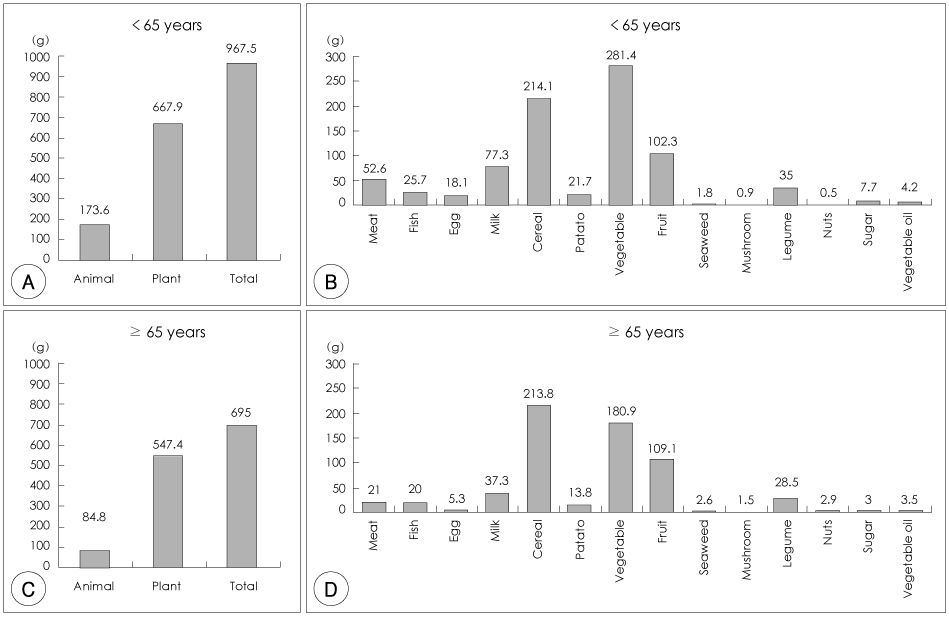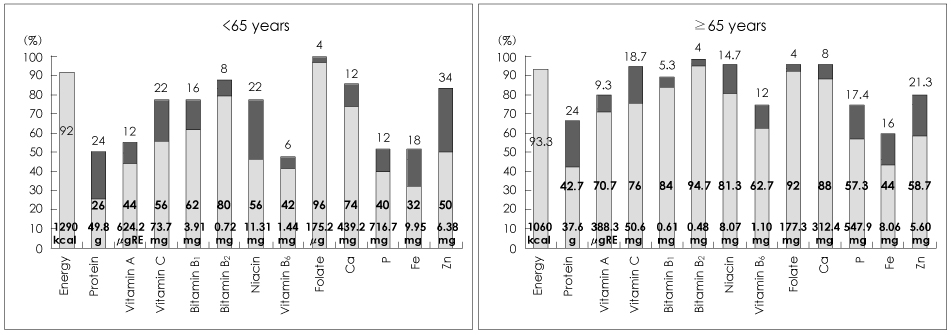Socioeconomic Factors Relating to Obesity and Inadequate Nutrient Intake in Women in Low Income Families Residing in Seoul
- Affiliations
-
- 1Department of Nutritional Science and Food Management, Ewha Womans University, Seoul 120-750, Korea. wykim@ewha.ac.kr
- 2The Catholic University of Korea, St. Paul's Hospital, Seoul 130-709, Korea.
- 3CJ Corp. Foods R&D, Seoul 152-050, Korea.
- KMID: 2264096
- DOI: http://doi.org/10.4163/kjn.2009.42.2.171
Abstract
- This study was performed to investigate socioeconomic factors relating to obesity and inadequate nutrient intake in women in low income families residing in Seoul. The subjects were 125 women (aged 41-87 y) recruited from the local health center for free health examination for low income families. The socioeconomic status such as educational level, income level, and housing condition were poor. For subjects aged less than 65 years, the prevalence of obesity was 44% based on BMI (> or = 25 kg/m2), 48% based on WHR (> or = 0.85), and 50% based on waist circumference (> or = 80 cm) and for those more than 65 years, these were greater and 57%, 81%, and 79%, respectively. The main food sources of daily diet were vegetables, grains, and fruits. Energy and other nutrient intake was not adequate for all subjects and the inadequacy was more profound in the elderly, showing percentages of subjects whose intake was less than EAR were greater than 50% for all nutrients except for iron and below RI were also greater than 50% for all nutrients. The prevalence of obesity and nutrient inadequacy were not associated with socioeconomic status in subjects aged less than 65 years, however, obesity was associated with household income and nutrient inadequacy was related to education (vitamin A) and housing status (protein, phosphate, and iron) in the elderly. After adjustment for ages, in the elderly, OR for obesity (BMI > or = 25, OR = 12.601; 95% CI = 2.338-67.911) and central obesity (WC > or = 80 cm, OR = 4.778; 95% CI = 1.103-20.696) were greater in subjects who earned less than 500 thousand Won per month than who earned more. For inadequate nutrient intake, the OR for inadequate intake of Vitamin A (OR = 4.555; 95% CI = 1.491-13.914) was greater in subjects with no education than those educated. Subjects without her own house had greater risk for inadequate intake for protein (OR = 3.660; 95% CI = 1.118-11.981), phosphate (OR = 3.428; 95% CI = 1.157-10.158), and iron (OR = 3.765; 95% CI = 1.205-11.766) than subjects possessing her house. In elderly females in low income families, the socioeconomic status was associated with the risk for obesity (income level) and inadequate nutrient intake (education level and housing status). More attention on these groups should be given for prevention of obesity and inadequate nutrient intake.
MeSH Terms
Figure
Cited by 4 articles
-
Relationship between Stress and Eating Habits of Adults in Ulsan
Hye-Kyung Kim, Jin-Hee Kim
Korean J Nutr. 2009;42(6):536-546. doi: 10.4163/kjn.2009.42.6.536.Food deserts in Korea? A GIS analysis of food consumption patterns at sub-district level in Seoul using the KNHANES 2008-2012 data
Dohyeong Kim, Chang Kil Lee, Dong Yeon Seo
Nutr Res Pract. 2016;10(5):530-536. doi: 10.4162/nrp.2016.10.5.530.A study on nutritional intakes in middle income adults based on data from the 5th Korean National Health and Nutrition Examination Survey
Ji-Myung Kim, Hye Sook Kim, Ki Nam Kim
J Nutr Health. 2015;48(4):364-370. doi: 10.4163/jnh.2015.48.4.364.Socio-economic status is associated with the risk of inadequate energy intake among Korean elderly
Eun Jin So, Hyojee Joung
J Nutr Health. 2015;48(4):371-379. doi: 10.4163/jnh.2015.48.4.371.
Reference
-
1. The First Korea National Health & Nutrition Examination Survey (KNHANES I). 1998. Seoul: Ministry of health and welfare.2. The Second Korea National Health & Nutrition Examination Survey (KNHANES II). 2001. Seoul: Ministry of health and welfare.3. The Third Korea National Health & Nutrition Examination Survey (KNHANES III). 2005. Seoul: Ministry of health and welfare.4. Popkin BM. Worldwide trends in obesity. J Nutr Biochem. 1998. 9(9):487–488.
Article5. Wamala SP, Wolk A, Orth-Gomér K. Determinants of obesity in relation to socioeconomic status among middle-aged Swedish women. Prev Med. 1997. 26(5):734–744.
Article6. Vescio MF, Smith GD, Giampaoli S. Socio-economic position and cardiovascular risk factors in an Italian rural population. Eur J Epidemiol. 2001. 17(5):449–459.7. Wang Y, Zhang Q. Are American children and adolescents of low socioeconomic status at increased risk of obesity? Changes in the association between overweight and family income between 1971 and 2002. Am J Clin Nutr. 2006. 84(4):707–716.
Article8. Lynch JW, Kaplan GA, Salonen JT. Why do poor people behave poorly? Variations in adult health behaviour and psychosocial characteristics, by stage of the socioeconomic lifecourse. Soc Sci Med. 1997. 44(6):809–819.
Article9. Prescott-Clarke P, Primatesta P. Health Survey for England. 1996. London: The Stationary Office.10. Wardle J, Waller J, Jarvis MJ. Sex differences in the association of socioeconomic status with obesity. Am J Public Health. 2002. 92(8):1299–1304.
Article11. Robert SA, Reither EN. A multilevel analysis of race, community disadvantage and body mass index among adults in the US. Soc Sci Med. 2004. 59(12):2421–2434.
Article12. Zhang Q, Wang Y. Socioeconomic inequality of obesity in the United States: do gender, age, and ethnicity matter? Soc Sci Med. 2004. 58(6):1171–1180.
Article13. Dietz WH. Does hunger cause obesity? Pediatrics. 1995. 95(5):766–767.
Article14. Brownell KD, Greenwood MRC, Stella E, Shrager EE. The effects of repeated cycles of weight loss and regain in rats. Physiol Behav. 1986. 38(4):459–464.
Article15. Drewnowski A, Specter SE. Poverty and obesity: the role of energy density and energy costs. Am J Clin Nutr. 2004. 79(1):6–16.
Article16. Olson CM. Nutrition and health outcomes associated with food insecurity and hunger. J Nutr. 1999. 129:521–524.
Article17. Adams EJ, Grummer-Strawn L, Chavez G. Food insecurity is associated with increased risk of obesity in California women. J Nutr. 2003. 133(4):1070–1074.
Article18. Sarlio-Lähteenkorva S, Lahelma E. Food insecurity is associated with past and present economic disadvantage and body mass index. J Nutr. 2001. 131(11):2880–2884.
Article19. Tarasuk VS. Household food insecurity with hunger is associated with women's food intakes, health and household circumstances. J Nutr. 2001. 131(10):2670–2676.
Article20. Yoon GA. The relation of educational level and life-style behaviors to obesity in adult males. Korean J Nutr. 2004. 37(5):385–393.21. Yoon GA. Association of obesity with television watching and physical activity in adult female. Korean J Nutr. 2003. 36(7):769–776.22. Lee KM, Kim HY, Jung SP, Kim JH, Song CH. Effects of cigarette smoking on abdominal fatness. J Korean Acad Fam Med. 2000. 21(9):1172–1179.23. Jeon HJ, Lee JH. Effect of Exercise on serum lipids in abdominal obese women. Korean J Food & Nutr. 2003. 16(3):192–196.24. Dietary Reference Intakes for Koreans. 2005. Seoul: The Korean Nutrition Society.25. Freidwald WT, Levy RI, Fredrickson DS. Estimation of concentration of the low-density lipoprotein cholesterol in plasma, without use of the preparative ultracentrifuge. Clin Chem. 1972. 18(6):499–502.26. Ball K, Mishra G, Crawford D. Which aspects of socioeconomic status are related to obesity among men and women? Int J Obes Relat Metab Disord. 2002. 26(4):559–565.
Article27. Choi JH, Kim MH, Cho MS, Lee HS, Kim WY. The nutritional status and dietary pattern by BMI and in Korean elderly. Korean J Nutr. 2002. 35(4):480–488.28. Kim WY, Ahn SY, Song YS. The nutritional status and intervention effects of multivitamin-mineral supplementation in nursing-home residents in Korea. Korean J Community Nutrition. 2000. 5(2):201–207.29. Kim MH, Hwang CG, Cho MS, Baik HW, Kim WY. The nutritional risk factors and preference to salty taste according to blood pressure in Korean elderly. Korean J Gerontol. 2005. 15(4):8–16.30. Park HJ, Lim BK, Kim WY. Effect of food commodity supplementary program for low income elderly people. Korean J Food Culture. 2007. 22(1):149–156.
- Full Text Links
- Actions
-
Cited
- CITED
-
- Close
- Share
- Similar articles
-
- Comparison of the health and nutritional status of Korean elderly considering the household income level, using the 2018 Korea National Health and Nutrition Examination Survey
- Food and Nutrient Intakes According to Income in Korean Men and Women
- Assessment of Nutrient Intake for Middle Aged with and without Metabolic Syndrome Using 2005 and 2007 Korean National Health and Nutrition Survey
- Diet Quality and Food Patterns of Obese Adult Women from Low Income Classes: Based on 2005 KNHANES
- A Comparison of Nutritional Status and Muscle Strength of Elderly Women in a Social Welfare Center and Those Residing at Home



